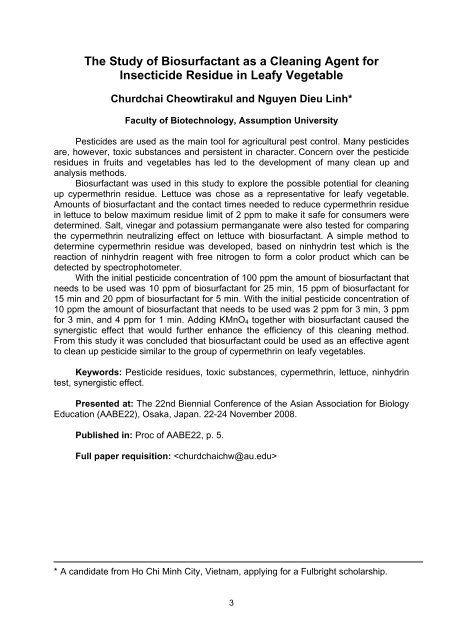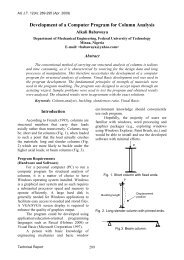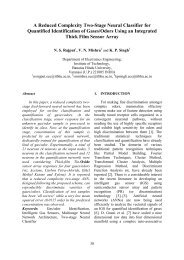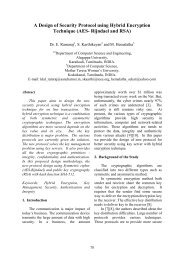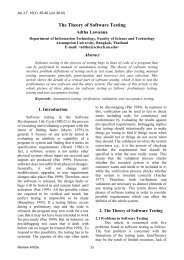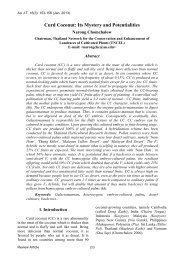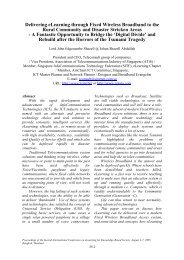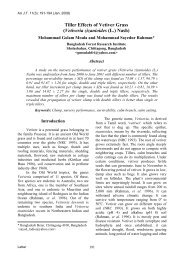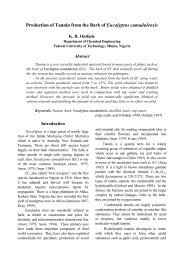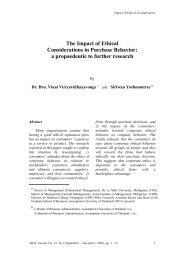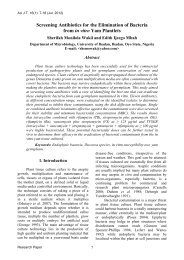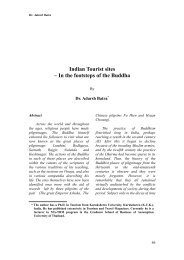AU Abstracts 2009 - AU Journal - Assumption University of Thailand
AU Abstracts 2009 - AU Journal - Assumption University of Thailand
AU Abstracts 2009 - AU Journal - Assumption University of Thailand
Create successful ePaper yourself
Turn your PDF publications into a flip-book with our unique Google optimized e-Paper software.
The Study <strong>of</strong> Biosurfactant as a Cleaning Agent for<br />
Insecticide Residue in Leafy Vegetable<br />
Churdchai Cheowtirakul and Nguyen Dieu Linh*<br />
Faculty <strong>of</strong> Biotechnology, <strong>Assumption</strong> <strong>University</strong><br />
Pesticides are used as the main tool for agricultural pest control. Many pesticides<br />
are, however, toxic substances and persistent in character. Concern over the pesticide<br />
residues in fruits and vegetables has led to the development <strong>of</strong> many clean up and<br />
analysis methods.<br />
Biosurfactant was used in this study to explore the possible potential for cleaning<br />
up cypermethrin residue. Lettuce was chose as a representative for leafy vegetable.<br />
Amounts <strong>of</strong> biosurfactant and the contact times needed to reduce cypermethrin residue<br />
in lettuce to below maximum residue limit <strong>of</strong> 2 ppm to make it safe for consumers were<br />
determined. Salt, vinegar and potassium permanganate were also tested for comparing<br />
the cypermethrin neutralizing effect on lettuce with biosurfactant. A simple method to<br />
determine cypermethrin residue was developed, based on ninhydrin test which is the<br />
reaction <strong>of</strong> ninhydrin reagent with free nitrogen to form a color product which can be<br />
detected by spectrophotometer.<br />
With the initial pesticide concentration <strong>of</strong> 100 ppm the amount <strong>of</strong> biosurfactant that<br />
needs to be used was 10 ppm <strong>of</strong> biosurfactant for 25 min, 15 ppm <strong>of</strong> biosurfactant for<br />
15 min and 20 ppm <strong>of</strong> biosurfactant for 5 min. With the initial pesticide concentration <strong>of</strong><br />
10 ppm the amount <strong>of</strong> biosurfactant that needs to be used was 2 ppm for 3 min, 3 ppm<br />
for 3 min, and 4 ppm for 1 min. Adding KMnO 4 together with biosurfactant caused the<br />
synergistic effect that would further enhance the efficiency <strong>of</strong> this cleaning method.<br />
From this study it was concluded that biosurfactant could be used as an effective agent<br />
to clean up pesticide similar to the group <strong>of</strong> cypermethrin on leafy vegetables.<br />
Keywords: Pesticide residues, toxic substances, cypermethrin, lettuce, ninhydrin<br />
test, synergistic effect.<br />
Presented at: The 22nd Biennial Conference <strong>of</strong> the Asian Association for Biology<br />
Education (AABE22), Osaka, Japan. 22-24 November 2008.<br />
Published in: Proc <strong>of</strong> AABE22, p. 5.<br />
Full paper requisition: <br />
* A candidate from Ho Chi Minh City, Vietnam, applying for a Fulbright scholarship.<br />
3


